
Rolls-Royce Owners' Club
of Australia Library
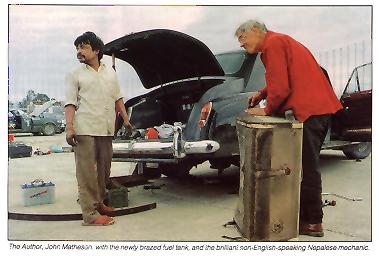
The Peking to Paris Motor Challenge
Leg Two - Kathmandu to Istanbul - the ugly face of motor sport
By John Matheson, 1998
Kathmandu was a rest day. It proved to be the first bit of
civilisation we had experienced since travelling through the grinding
poverty and subsistence living of Tibet. The Yak & Yeti
Hotel was a pleasant place to stay and we were able to have a beer at
last as previously we had been abstemious since Lanzhou;
alcohol and high altitudes do not mix well. Even in Kathmandu it
was difficult to drink alcohol even though we knew we were
facing the dry countries of Pakistan and Iran to come. The
contrast between the Yak & Yeti Hotel and the Choksom
Hotel was quite startling. The Choksom Hotel had not been occupied
for six years, plumbing did not work, there was no lighting -
only a diesel generator which was turned off when the meal was
over, and a pig had to be chased out of the front of the hotel
before people could go in there.
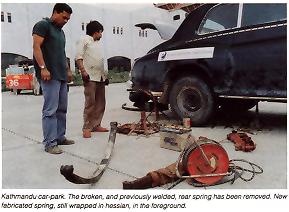 Jeanne had arranged for the Mercedes mechanic to come out and
have a look at our car. He took the spring out in the
compound where the car was parked rather than taking it into
the workshop as the
Phantom was too large. The old spring was taken away and a brand
new spring fabricated. It fined perfectly and was made
from correct materials. The car was again fully functional. They
took the fuel tank out and braised it up so that it was working
properly too. We now had a car functioning on all systems. One
of the competitors whose family owns a large part of the
Daimler Benz corporation apparently visited the Mercedes workshop
in Kathmandu and was horrified to note that it had very
few facilities and that their chief mechanic was working on a
Rolls-Royce. By this stage everybody had become pretty self-sufficient
as far as trying to do their own repairs were concerned. The back-up
vehicles for the Rally were not much use. All
that they could manage was bandaid-type repairs.
Jeanne had arranged for the Mercedes mechanic to come out and
have a look at our car. He took the spring out in the
compound where the car was parked rather than taking it into
the workshop as the
Phantom was too large. The old spring was taken away and a brand
new spring fabricated. It fined perfectly and was made
from correct materials. The car was again fully functional. They
took the fuel tank out and braised it up so that it was working
properly too. We now had a car functioning on all systems. One
of the competitors whose family owns a large part of the
Daimler Benz corporation apparently visited the Mercedes workshop
in Kathmandu and was horrified to note that it had very
few facilities and that their chief mechanic was working on a
Rolls-Royce. By this stage everybody had become pretty self-sufficient
as far as trying to do their own repairs were concerned. The back-up
vehicles for the Rally were not much use. All
that they could manage was bandaid-type repairs.
Furthermore they had come along with some Vauxhall Frontierers, a
new 4-wheel drive vehicle being marketed in Europe.
These vehicles proved to be useless. They blew their shock
absorbers in the first day out of Beijing and their springs all
collapsed. The back-up crew spent most of their time working on
their own vehicles and eventually in Lhasa rebuilt them
using Toyota components for the suspension to try to make them work.
There were amazing stories from the other competitors of keeping
cars going. One of the Railtons had its engine pulled apart
twice on the trip and new bearings put in. A Deux Chevaux drove
in one day on three wheels having broken a front wheel with
the driver sitting in the passenger seat steering and the navigator
standing out on the rear bumper to balance the car.
Extensive suspension re-building was done. One of the Citroens
which broke its front suspension called into a local farm where
the components were welded accurately and they were able to
keep going on that. A Morris Minor travelled half of the trip on
a welded con-rod. Kathmandu was the first place that we could
get effective repairs done and a lot of people took the
opportunity of rebuilding their suspensions at that stage.
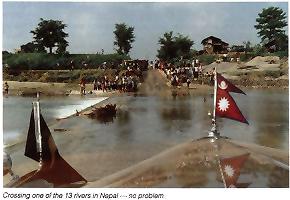 The Rolls-Royce and Bentley cars on
the rally were by and large trouble-free and apart from the
boat-tailed Phantom I pulling out in
Kathmandu they all finished. lie boat-tail could have gone on
but he and his wife decided they had
had enough and would not continue. We eventually headed out into
West Nepal and in one day we
had something like thirteen river crossings. Fortunately
the rivers were not very high. There was
water up to nine inches deep on a stony base with a lot of
ruts. A few cars broke down and had to
be towed out of the water. The Phantom handled these
conditions with equanimity. Its great weight
and adequate clearance allowed it to simply motor through
these conditions without any trouble at
all.
The Rolls-Royce and Bentley cars on
the rally were by and large trouble-free and apart from the
boat-tailed Phantom I pulling out in
Kathmandu they all finished. lie boat-tail could have gone on
but he and his wife decided they had
had enough and would not continue. We eventually headed out into
West Nepal and in one day we
had something like thirteen river crossings. Fortunately
the rivers were not very high. There was
water up to nine inches deep on a stony base with a lot of
ruts. A few cars broke down and had to
be towed out of the water. The Phantom handled these
conditions with equanimity. Its great weight
and adequate clearance allowed it to simply motor through
these conditions without any trouble at
all.
We left Nepal to go into India and the unpleasant part
of the journey began. Indian customs had
been paid a $16,000 bribe to allow us through but
apparently this had not been handed down the
line and a process of bureaucratic obstruction began
at the border. They asked for another $5,000
but this was refused and the consequence of this was
a six hour delay while they laboriously
handwrote all the details of the vehicles four times
over at four different desks before we got into
India.
Signs of resentment and unpleasantness also began in
India with the beginnings of some stone-throwing, rude
gestures and trucks attempting to run us off the road.
However it was not too bad m
India. Delhi itself was relatively pleasant.
We eventually travelled up through Amritsar across the
border into Pakistan. The Indians after the
row that had been created had evidently decided not
to ask for another bribe on the way out of
India although initially they had done so. The
obstruction to us leaving India was not so great.
Nevertheless the Indians did not cam many brownie
points for the way they treated us.
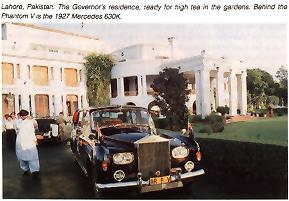 The next destination was Lahore. The Pakistanis
were co-operative and pleasant at the border and
Lahore was an island of civilisation in what was
to turn out to be virtual warfare over the next eight
days after we left Lahore. There was a pleasant
interlude with a garden party with the Governor of
Lahore in a very British tradition and then it
was on into Baluchistan. We climbed up to Fort
Monro which took us up into Baluchistan. Things
began to go very wrong at this stage.
The next destination was Lahore. The Pakistanis
were co-operative and pleasant at the border and
Lahore was an island of civilisation in what was
to turn out to be virtual warfare over the next eight
days after we left Lahore. There was a pleasant
interlude with a garden party with the Governor of
Lahore in a very British tradition and then it
was on into Baluchistan. We climbed up to Fort
Monro which took us up into Baluchistan. Things
began to go very wrong at this stage.
There were two earlier incidents. In Nainatal in
India a Landrover had been travelling into the night
after a long day, something we were told would not
happen. The days were too long and the competition too great.
They pulled over to the side of the road to allow
a bus to pass but got too near the edge and fell
over. They fell about forty feet down onto a small
platform and were held up by a tree from falling
another 100 metres down a gorge. But for this tree
on the edge of this cliff they would not have
survived. As it was they were not able to continue
the journey and had sustained some minor
injuries including one of them receiving a crushed
cervical vertebra. Their vehicle was then trucked
down to Delhi for repatriation to Britain but on
the way down to Delhi the Indians stripped the
vehicle and took everything moveable off it that
they could take.
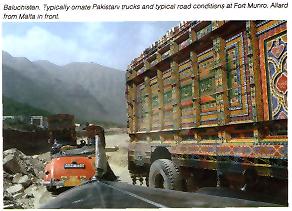 The next ugly incident was to occur in Baluchistan.
The climb up on to the Baluchistan plateau was
a difficult road and heavily populated with Pakistani
trucks. It took us into an area that is not
controlled by Pakistan. Although Baluchistan is part
of Pakistan there is no control up there. The
Pakistani police would not drive up the road to Fort
Munro. The road itself was supposed to be a
closed stage in the rally but the Pakistani truck
drivers would not stop. Even those that were paid
money at the top of the pass not to go down merely
took the money and continued to drive. For
them it was sport. They simply came down the middle
of the road and would not move and drove
every car off the road. It became an endless game
of 'chicken' with these Pakistani drivers roaring
with laughter as they pushed us off the sides of
the road. The road was a one lane tar road with poor
shoulders and many of the cars tore their tyres.
Under these conditions there were frequent
punctures and some cars were side-swiped including
our own although we did not sustain very
much damage.
The next ugly incident was to occur in Baluchistan.
The climb up on to the Baluchistan plateau was
a difficult road and heavily populated with Pakistani
trucks. It took us into an area that is not
controlled by Pakistan. Although Baluchistan is part
of Pakistan there is no control up there. The
Pakistani police would not drive up the road to Fort
Munro. The road itself was supposed to be a
closed stage in the rally but the Pakistani truck
drivers would not stop. Even those that were paid
money at the top of the pass not to go down merely
took the money and continued to drive. For
them it was sport. They simply came down the middle
of the road and would not move and drove
every car off the road. It became an endless game
of 'chicken' with these Pakistani drivers roaring
with laughter as they pushed us off the sides of
the road. The road was a one lane tar road with poor
shoulders and many of the cars tore their tyres.
Under these conditions there were frequent
punctures and some cars were side-swiped including
our own although we did not sustain very
much damage.
Once in Baluchistan it became evident that the place
was quite lawless. Every male carried a rifle and
there wore no police. We drove on from Fort Munro to
Quetta where we stayed in some pretty fleabitten hotels.
The standard of the hotels remained poor until we arrived in Western Iran.
The long day into Quetta was a competitive day and the
times were not achievable for cars. The day
was so long that it again took us into the night. The
final control for the day was in the hotel inside
Quetta. Thus there were cars racing to
make time through the busy peak-hour traffic of Quetta.
This resulted in the deaths of two of the
competitors; a father and son who were in a Volkswagen
convertible. They had been travelling at
great speed through the town. They went round some trucks
and ran underneath a bus.
When we came into the town we passed the bus which
had extensive damage underneath the front
where the car had gone underneath it and we made some
flippant comments at the time. When we
turned round the corner we were horrified to see the
remains of the Volkswagen on the back of a
forklift truck. It was a gut-wrenching feeling waiting
to find out how they were. One of them was
killed instantly and the other died shortly thereafter
in the hospital without regaining consciousness.
One can understand why competitive rallies are not
permitted on open roads in western countries. To run a
competitive road race such as this, going into a town
at nighttime to a control in a hotel was to my
mind quite irresponsible. It was the second nightstage.
The first one had nearly lead to the death of
two contestants and this stage had lead to two deaths.
Some of the Germans stayed behind in
Quetta to arrange the repatriation of the bodies. Most
of the red of us then continued on to
Iran, across the border with the minimum of formalities
and drove on to Zahedan.
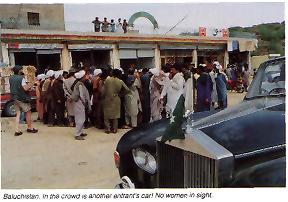 Zahedan is a frontier town quite close to Afghanistan
and near the Pakistan border. It is a lawless
town and a town which is a major drug trans-shipment
centre ftom the poppy and hemp fields of
Afghanistan.
It is also Baluchi populated. The advice was not to
leave the town at all and not be out in the town
at night time. Now that we were in Iran the lack of
alcohol was absolute but alcohol had been
unobtainable in Pakistan in any case. The female
contestants had to wear covering clothes and a veil
to cover their hair. It was in Iran that the viciousness
of the crowds became pervasive. The stoning
of the cars was continuous and a lot of damage was
done. The people in the open cars were hit and
some of them sustained minor injuries. Fortunately
there were no major injuries. We had a lucky
escape when a fairly large stone went past my ear
and hit the glass division in the Phantom and
bounced and hit Jeanne on the hand causing her some
bruising. There were some quite deep
stone-chips in the vehicles. Some of the vehicles
were hit with sticks and there was at least one
attempt to pull a driver out of one of the open cars.
At every village you came to you would be
ambushed by people blocking the roads and throwing
stones as you went past. The vicious stone
throwing was done by young adults but the
children were also involved. They would tie stones to
flowers and throw them at you. Some of the women
spat on. The police who were pervasive
throughout the trip made no attempt to intervene
and the matter continued all the way to Turkey.
Zahedan is a frontier town quite close to Afghanistan
and near the Pakistan border. It is a lawless
town and a town which is a major drug trans-shipment
centre ftom the poppy and hemp fields of
Afghanistan.
It is also Baluchi populated. The advice was not to
leave the town at all and not be out in the town
at night time. Now that we were in Iran the lack of
alcohol was absolute but alcohol had been
unobtainable in Pakistan in any case. The female
contestants had to wear covering clothes and a veil
to cover their hair. It was in Iran that the viciousness
of the crowds became pervasive. The stoning
of the cars was continuous and a lot of damage was
done. The people in the open cars were hit and
some of them sustained minor injuries. Fortunately
there were no major injuries. We had a lucky
escape when a fairly large stone went past my ear
and hit the glass division in the Phantom and
bounced and hit Jeanne on the hand causing her some
bruising. There were some quite deep
stone-chips in the vehicles. Some of the vehicles
were hit with sticks and there was at least one
attempt to pull a driver out of one of the open cars.
At every village you came to you would be
ambushed by people blocking the roads and throwing
stones as you went past. The vicious stone
throwing was done by young adults but the
children were also involved. They would tie stones to
flowers and throw them at you. Some of the women
spat on. The police who were pervasive
throughout the trip made no attempt to intervene
and the matter continued all the way to Turkey.
On the last day it got so bad in the Kurdish part
of Iran that we decided to leave two hours early at
five in the morning and go at short intervals to
try and get out without further stoning but this was
to no avail. The last hour to Horasan was as bad
as any from stoning. Despite our early arrival they had
managed to ambush us and m some places there were
people stoning from both sides of the road
especially at the open cars. We eventually got
across the border into Turkey near Mt Ararat. It was
a beautiful clear day and Mt Ararat was clearly
visible without any cloud cover. What a relief to get
into Turkey.
I think Iran should be crossed off the lexicon of
travellers until such time as these savages learn some
elementary points about civilisation.
Eastern Turkey was quite tense. The Turks had just
invaded the Iraqi part of Kurdistan and we were
in Kurdish territory. We were warned not to be out
on the roads at night and were told that the
Turkish police would not come out for us at nighttime
as we would be safer on our own. If they
went out they would be shot by the Kurds. 'Mere was
quite a lot of banditry going on. There was a
lot of military action and along the roads in this
part of Kurdistan the only vehicles from the
government side were either tanks or armoured cars.
However the locals were pleasant enough to us.
There was an immediate and obvious increase in the
standard of living in Turkey as compared to Iran.
Iran had all the signs of an economy in retreat with
half-completed buildings and mud huts
everywhere. Apart from a few mud hutted Kurdish
villages Turkey was clearly a much richer
country and provided us with a welcome bit of
civilisation. The scarves were discarded and alcohol
was available.
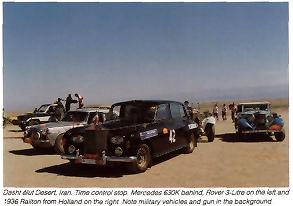 We went to a town called Nevsehir where we stayed at
a skiing chalet up a quite steep mountain. We
drove on past some of the cliff dwellings and then
eventually travelled through some very beautiful
country into Istanbul. This proved to be another rest
day and for me was the only day that I did not
spend either travelling or working on the car all day.
I took the opportunity of spending the entire
day in bed. I am afraid sightseeing and touring were
not things that featured much on this trip. By
this time we had teamed up quite closely with the
Mercedes 630K and we tended to travel in
convoy. The Mercedes was to have one further bout
of magneto problems but eventually completed
the trip using my spare coil and bypassing his magneto.
We went to a town called Nevsehir where we stayed at
a skiing chalet up a quite steep mountain. We
drove on past some of the cliff dwellings and then
eventually travelled through some very beautiful
country into Istanbul. This proved to be another rest
day and for me was the only day that I did not
spend either travelling or working on the car all day.
I took the opportunity of spending the entire
day in bed. I am afraid sightseeing and touring were
not things that featured much on this trip. By
this time we had teamed up quite closely with the
Mercedes 630K and we tended to travel in
convoy. The Mercedes was to have one further bout
of magneto problems but eventually completed
the trip using my spare coil and bypassing his magneto.
to be continued...
Previous Leg
Next Leg
RROC(A) Online Library
RROC(A) Main Page
 Jeanne had arranged for the Mercedes mechanic to come out and
have a look at our car. He took the spring out in the
compound where the car was parked rather than taking it into
the workshop as the
Phantom was too large. The old spring was taken away and a brand
new spring fabricated. It fined perfectly and was made
from correct materials. The car was again fully functional. They
took the fuel tank out and braised it up so that it was working
properly too. We now had a car functioning on all systems. One
of the competitors whose family owns a large part of the
Daimler Benz corporation apparently visited the Mercedes workshop
in Kathmandu and was horrified to note that it had very
few facilities and that their chief mechanic was working on a
Rolls-Royce. By this stage everybody had become pretty self-sufficient
as far as trying to do their own repairs were concerned. The back-up
vehicles for the Rally were not much use. All
that they could manage was bandaid-type repairs.
Jeanne had arranged for the Mercedes mechanic to come out and
have a look at our car. He took the spring out in the
compound where the car was parked rather than taking it into
the workshop as the
Phantom was too large. The old spring was taken away and a brand
new spring fabricated. It fined perfectly and was made
from correct materials. The car was again fully functional. They
took the fuel tank out and braised it up so that it was working
properly too. We now had a car functioning on all systems. One
of the competitors whose family owns a large part of the
Daimler Benz corporation apparently visited the Mercedes workshop
in Kathmandu and was horrified to note that it had very
few facilities and that their chief mechanic was working on a
Rolls-Royce. By this stage everybody had become pretty self-sufficient
as far as trying to do their own repairs were concerned. The back-up
vehicles for the Rally were not much use. All
that they could manage was bandaid-type repairs.


 The Rolls-Royce and Bentley cars on
the rally were by and large trouble-free and apart from the
boat-tailed Phantom I pulling out in
Kathmandu they all finished. lie boat-tail could have gone on
but he and his wife decided they had
had enough and would not continue. We eventually headed out into
West Nepal and in one day we
had something like thirteen river crossings. Fortunately
the rivers were not very high. There was
water up to nine inches deep on a stony base with a lot of
ruts. A few cars broke down and had to
be towed out of the water. The Phantom handled these
conditions with equanimity. Its great weight
and adequate clearance allowed it to simply motor through
these conditions without any trouble at
all.
The Rolls-Royce and Bentley cars on
the rally were by and large trouble-free and apart from the
boat-tailed Phantom I pulling out in
Kathmandu they all finished. lie boat-tail could have gone on
but he and his wife decided they had
had enough and would not continue. We eventually headed out into
West Nepal and in one day we
had something like thirteen river crossings. Fortunately
the rivers were not very high. There was
water up to nine inches deep on a stony base with a lot of
ruts. A few cars broke down and had to
be towed out of the water. The Phantom handled these
conditions with equanimity. Its great weight
and adequate clearance allowed it to simply motor through
these conditions without any trouble at
all.
 The next destination was Lahore. The Pakistanis
were co-operative and pleasant at the border and
Lahore was an island of civilisation in what was
to turn out to be virtual warfare over the next eight
days after we left Lahore. There was a pleasant
interlude with a garden party with the Governor of
Lahore in a very British tradition and then it
was on into Baluchistan. We climbed up to Fort
Monro which took us up into Baluchistan. Things
began to go very wrong at this stage.
The next destination was Lahore. The Pakistanis
were co-operative and pleasant at the border and
Lahore was an island of civilisation in what was
to turn out to be virtual warfare over the next eight
days after we left Lahore. There was a pleasant
interlude with a garden party with the Governor of
Lahore in a very British tradition and then it
was on into Baluchistan. We climbed up to Fort
Monro which took us up into Baluchistan. Things
began to go very wrong at this stage.
 The next ugly incident was to occur in Baluchistan.
The climb up on to the Baluchistan plateau was
a difficult road and heavily populated with Pakistani
trucks. It took us into an area that is not
controlled by Pakistan. Although Baluchistan is part
of Pakistan there is no control up there. The
Pakistani police would not drive up the road to Fort
Munro. The road itself was supposed to be a
closed stage in the rally but the Pakistani truck
drivers would not stop. Even those that were paid
money at the top of the pass not to go down merely
took the money and continued to drive. For
them it was sport. They simply came down the middle
of the road and would not move and drove
every car off the road. It became an endless game
of 'chicken' with these Pakistani drivers roaring
with laughter as they pushed us off the sides of
the road. The road was a one lane tar road with poor
shoulders and many of the cars tore their tyres.
Under these conditions there were frequent
punctures and some cars were side-swiped including
our own although we did not sustain very
much damage.
The next ugly incident was to occur in Baluchistan.
The climb up on to the Baluchistan plateau was
a difficult road and heavily populated with Pakistani
trucks. It took us into an area that is not
controlled by Pakistan. Although Baluchistan is part
of Pakistan there is no control up there. The
Pakistani police would not drive up the road to Fort
Munro. The road itself was supposed to be a
closed stage in the rally but the Pakistani truck
drivers would not stop. Even those that were paid
money at the top of the pass not to go down merely
took the money and continued to drive. For
them it was sport. They simply came down the middle
of the road and would not move and drove
every car off the road. It became an endless game
of 'chicken' with these Pakistani drivers roaring
with laughter as they pushed us off the sides of
the road. The road was a one lane tar road with poor
shoulders and many of the cars tore their tyres.
Under these conditions there were frequent
punctures and some cars were side-swiped including
our own although we did not sustain very
much damage.
 Zahedan is a frontier town quite close to Afghanistan
and near the Pakistan border. It is a lawless
town and a town which is a major drug trans-shipment
centre ftom the poppy and hemp fields of
Afghanistan.
It is also Baluchi populated. The advice was not to
leave the town at all and not be out in the town
at night time. Now that we were in Iran the lack of
alcohol was absolute but alcohol had been
unobtainable in Pakistan in any case. The female
contestants had to wear covering clothes and a veil
to cover their hair. It was in Iran that the viciousness
of the crowds became pervasive. The stoning
of the cars was continuous and a lot of damage was
done. The people in the open cars were hit and
some of them sustained minor injuries. Fortunately
there were no major injuries. We had a lucky
escape when a fairly large stone went past my ear
and hit the glass division in the Phantom and
bounced and hit Jeanne on the hand causing her some
bruising. There were some quite deep
stone-chips in the vehicles. Some of the vehicles
were hit with sticks and there was at least one
attempt to pull a driver out of one of the open cars.
At every village you came to you would be
ambushed by people blocking the roads and throwing
stones as you went past. The vicious stone
throwing was done by young adults but the
children were also involved. They would tie stones to
flowers and throw them at you. Some of the women
spat on. The police who were pervasive
throughout the trip made no attempt to intervene
and the matter continued all the way to Turkey.
Zahedan is a frontier town quite close to Afghanistan
and near the Pakistan border. It is a lawless
town and a town which is a major drug trans-shipment
centre ftom the poppy and hemp fields of
Afghanistan.
It is also Baluchi populated. The advice was not to
leave the town at all and not be out in the town
at night time. Now that we were in Iran the lack of
alcohol was absolute but alcohol had been
unobtainable in Pakistan in any case. The female
contestants had to wear covering clothes and a veil
to cover their hair. It was in Iran that the viciousness
of the crowds became pervasive. The stoning
of the cars was continuous and a lot of damage was
done. The people in the open cars were hit and
some of them sustained minor injuries. Fortunately
there were no major injuries. We had a lucky
escape when a fairly large stone went past my ear
and hit the glass division in the Phantom and
bounced and hit Jeanne on the hand causing her some
bruising. There were some quite deep
stone-chips in the vehicles. Some of the vehicles
were hit with sticks and there was at least one
attempt to pull a driver out of one of the open cars.
At every village you came to you would be
ambushed by people blocking the roads and throwing
stones as you went past. The vicious stone
throwing was done by young adults but the
children were also involved. They would tie stones to
flowers and throw them at you. Some of the women
spat on. The police who were pervasive
throughout the trip made no attempt to intervene
and the matter continued all the way to Turkey.
 We went to a town called Nevsehir where we stayed at
a skiing chalet up a quite steep mountain. We
drove on past some of the cliff dwellings and then
eventually travelled through some very beautiful
country into Istanbul. This proved to be another rest
day and for me was the only day that I did not
spend either travelling or working on the car all day.
I took the opportunity of spending the entire
day in bed. I am afraid sightseeing and touring were
not things that featured much on this trip. By
this time we had teamed up quite closely with the
Mercedes 630K and we tended to travel in
convoy. The Mercedes was to have one further bout
of magneto problems but eventually completed
the trip using my spare coil and bypassing his magneto.
We went to a town called Nevsehir where we stayed at
a skiing chalet up a quite steep mountain. We
drove on past some of the cliff dwellings and then
eventually travelled through some very beautiful
country into Istanbul. This proved to be another rest
day and for me was the only day that I did not
spend either travelling or working on the car all day.
I took the opportunity of spending the entire
day in bed. I am afraid sightseeing and touring were
not things that featured much on this trip. By
this time we had teamed up quite closely with the
Mercedes 630K and we tended to travel in
convoy. The Mercedes was to have one further bout
of magneto problems but eventually completed
the trip using my spare coil and bypassing his magneto.